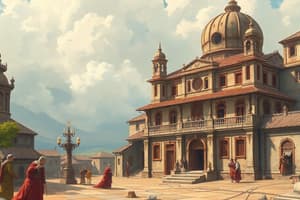Podcast
Questions and Answers
What was the significance of Nicolaus Copernicus's heliocentric theory during the Renaissance?
What was the significance of Nicolaus Copernicus's heliocentric theory during the Renaissance?
It challenged the traditional geocentric view and laid the foundation for modern astronomy.
How did Andreas Vesalius contribute to the field of anatomy?
How did Andreas Vesalius contribute to the field of anatomy?
He revolutionized the understanding of the human body through detailed studies and drawings.
In what ways did the printing press influence the dissemination of knowledge during the Renaissance?
In what ways did the printing press influence the dissemination of knowledge during the Renaissance?
It allowed scientists and scholars to spread their ideas more widely and rapidly than ever before.
What impact did advancements in engineering and architecture have during the Renaissance?
What impact did advancements in engineering and architecture have during the Renaissance?
What shift in thinking characterized the Renaissance compared to the medieval period?
What shift in thinking characterized the Renaissance compared to the medieval period?
Flashcards
Renaissance
Renaissance
A period of significant advancement in science and technology in Western world from A.D 1300 to A.D. 1550. It marked a shift from medieval thinking.
Heliocentric Theory
Heliocentric Theory
The theory that the sun is the center of the solar system, developed by Nicolaus Copernicus.
Andreas Vesalius
Andreas Vesalius
A Renaissance anatomist whose work revolutionized our understanding of the human body.
Printing Press
Printing Press
Signup and view all the flashcards
Modern Age beginnings
Modern Age beginnings
Signup and view all the flashcards
Study Notes
Renaissance: A Period of Advancement
- Marked a shift from medieval thinking to modern era, lasting from 1300 to 1550 in the West.
- Significant advancements in astronomy, anatomy, mathematics, and engineering.
- Nicolaus Copernicus' heliocentric theory challenged the geocentric view and revolutionized astronomy.
- Andreas Vesalius' anatomical studies transformed the understanding of the human body, impacting modern medicine.
- The printing press facilitated the rapid spread of knowledge.
- Engineering and architecture saw development of new techniques, leading to grand structures (e.g., cathedrals, palaces, bridges).
- Renaissance art incorporated perspective, influencing how the world was represented and understood.
- The era transitioned from reliance on tradition to an empirical approach to knowledge, a hallmark of modern science.
- Laid the groundwork for future scientific and technological advancements.
Studying That Suits You
Use AI to generate personalized quizzes and flashcards to suit your learning preferences.




